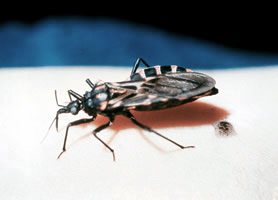The director of the National Eradication Service Vector-Borne Diseases says that the vector for parasitic disease, Chagas disease, is being found with more frequency in cities and urban areas, setting off an alarm in the South American country of Paraguay.

Image/CDC
Silvio Ortega says the vector, which goes by many names–kissing bug, triatomine bugs, assassin bug and chinche, is now moving toward urban areas where conditions are favorable for the bug to multiply, according to a Prensa Latina report Friday.
Until now, the argument was put forward that it could only be found in indigenous communities and rural areas, but the lack of cleanliness and housing insecurity led to its appearance in other areas. He explained that, unlike mosquitoes that transmit other diseases, the insect live generally between the bricks of the houses and other open spaces, because its normal habitat is dry; no moisture is required.
It is reported that 165,000 people in Paraguay suffer from the usually chronic disease. Itaguá, Cordillera and Paraguarí departments were identified as at-risk areas (Itaguá was once declared disease-free by the WHO).
According to the World Health Organization (WHO), Chagas disease, also known as American trypanosomiasis, is a potentially life-threatening illness caused by the protozoan parasite, Trypanosoma cruzi (T. cruzi). It is found mainly in endemic areas of 21 Latin American countries.
About 7 million to 8 million people worldwide are estimated to be infected with the parasite. For more infectious disease news and information, visit and “like” the Infectious Disease News Facebook page.
T. cruzi parasites are mainly transmitted by the infected feces of blood-sucking triatomine bugs. In addition, the parasite can be transmitted via food contaminated with T. cruzi through for example thecontact with triatomine bug feces, blood transfusions using blood from infected donors, passage from an infected mother to her newborn during pregnancy or childbirth, organ transplants using organs from infected donors and laboratory accidents.
Related story: Chagas disease in North America

